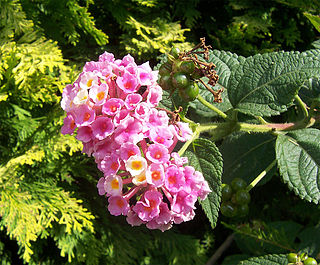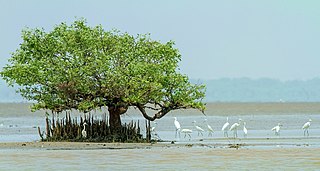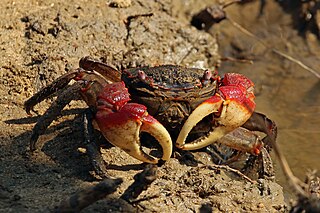
The Piper Islands National Park is a national park in Far North Queensland, Australia. It lies 1977 km northwest of Brisbane. It comprises four small islands lying on the inner northern Great Barrier Reef off the eastern coast of the Cape York Peninsula in Temple Bay, between Cape Grenville and Fair Cape.

The Verbenaceae, the verbena family or vervain family, is a family of mainly tropical flowering plants. It contains trees, shrubs, and herbs notable for heads, spikes, or clusters of small flowers, many of which have an aromatic smell.

Avicennia is a genus of flowering plants currently placed in the bear's breeches family, Acanthaceae. It contains mangrove trees, which occur in the intertidal zones of estuarine areas and are characterized by its "pencil roots", which are aerial roots. They are also commonly known as api api, which in the Malay language means "fires", a reference to the fact that fireflies often congregate on these trees. Species of Avicennia occur worldwide south of the Tropic of Cancer.

Avicennia marina, commonly known as grey mangrove or white mangrove, is a species of mangrove tree classified in the plant family Acanthaceae. As with other mangroves, it occurs in the intertidal zones of estuarine areas.

Coringa Wildlife Sanctuary is an estuary situated near Kakinada in Andhra Pradesh, India. It is the third largest stretch of mangrove forests in India with 24 mangrove tree species and more than 120 bird species. It is home to the critically endangered white-backed vulture and the long billed vulture. Mangroves are a group of trees and shrubs that live in the coastal intertidal zone, with a dense tangle of prop roots that make the trees appear to be standing on stilts above the water. This tangle of roots allows the trees to handle the daily rise and fall of tides; hence, the mangrove forest gets flooded at least twice per day. The roots also slow the movement of tidal waters, causing sediments to settle out of the water and build up the muddy bottom.

Avicennia germinans, the black mangrove, is a shrub or small tree growing up to 12 meters in the acanthus family, Acanthaceae. It grows in tropical and subtropical regions of the Americas, on both the Atlantic and Pacific Coasts, and on the Atlantic Coast of tropical Africa, where it thrives on the sandy and muddy shores where seawater reaches. It is common throughout coastal areas of Texas and Florida, and ranges as far north as southern Louisiana and coastal Georgia in the United States.
The Matlacha Pass National Wildlife Refuge is part of the United States National Wildlife Refuge System, located within the Matlacha Pass estuary, approximately 8 miles northwest of Fort Myers, Florida. The 538 acre (2.2 km2) refuge was established on September 26, 1908. The islands were established as a "preserve and breeding ground for native birds" by President Theodore Roosevelt. It is administered as part of the J. N. "Ding" Darling National Wildlife Refuge Complex.

The Mangrove forests of Qeshm or Hara forests of Qeshm, are the mangrove forests on the southern coast of Iran, particularly on and near the island of Qeshm in the Persian Gulf. Dominated by the species Avicennia marina, known locally as the "hara" or "harra" tree, the forests represent an important ecological resource. The "Hara Protected Area" on Quesm and the nearby mainland is a biosphere reserve where commercial use is restricted to fishing, tourist boat trips, and limited mangrove cutting for animal feed.

Cystiscinae are a taxonomic subfamily of minute sea snails. These are marine gastropod mollusks or micromollusks in the family Cystiscidae, and the clade Neogastropoda.
Intelcystiscus is a genus of minute sea snail, a marine gastropod mollusc or micromollusc in the family Cystiscidae.

Avicennia officinalis is a species of mangrove also known as Indian mangrove. The genus Avicennia is named after the famous Persian scientist Ibn Sina.

Avicennia alba is a species of tropical mangrove in the family Acanthaceae. It is found growing in coastal and estuarine locations in India, Southeast Asia, Australia, and Oceania.
Uppu Aru lagoon is a lagoon in Jaffna District, northern Sri Lanka. The lagoon separates the Valikamam region from the Thenmarachchi region.

The Southern Africa mangroves are mangrove ecoregion on the Mozambique's southernmost coast and the eastern coast of South Africa.

The Sunda Shelf mangroves ecoregion, in the mangrove biome, are on the coasts of the islands of Borneo and eastern Sumatra in Malaysia and Indonesia. They are home to the proboscis monkey.
Avicennia rumphiana is a species of tropical mangrove in the family Acanthaceae. It is considered vulnerable by the IUCN Red List of Threatened Species in the 2008 assessment. As of March 2022, Plants of the World Online considered it to be only a variety of Avicennia marina, Avicennia marina var. rumphiana. In the Malay language it is known as api api bulu.
Winninowie Conservation Park is a protected area in the Australian state of South Australia located on the east coast of Upper Spencer Gulf about 20 kilometres south by east of Port Augusta and 25 kilometres northwest of Port Germein, in the locality of Miranda. The conservation park was proclaimed in 1990 for the purpose of conserving ‘excellent examples of several coastal and marine ecosystems with sub-tropical affiliations in a temperate environment’ including ‘significant stands of the grey mangrove, Avicennia marina var. resinifera, seagrass and samphire salt marsh communities’. The conservation park's boundaries overlap with those of the Yatala Harbour Upper Spencer Gulf Aquatic Reserve. The conservation park is classified as an IUCN Category Ia protected area.
Rhizophora harrisonii is a species of plant in the family Rhizophoraceae. It can be found in Brazil, Cameroon, Colombia, Costa Rica, Ecuador, Guyana, French Guiana, Honduras, Nicaragua, Panama, Suriname, Trinidad, Tobago, and Venezuela.

The Trinidad mangroves ecoregion covers the separate mangrove forest areas on the coast of the island of Trinidad, in the country of Trinidad and Tobago. The character of the mangroves is affected by the large amount of fresh water flowing out of the Orinoco River and Amazon River to the south, which flow northwest around the island. The mangroves of Trinidad are found on all coasts, and are usually in the estuaries of rivers, but also found in coastal lagoons.












